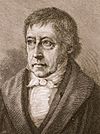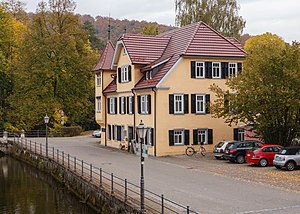Wikipedia:WikiProject Germany/Portal:Baden-Württemberg
Introduction

Baden-Württemberg (/ˌbɑːdən ˈvɜːrtəmbɜːrɡ/ BAH-dən VURT-əm-burg, German: [ˌbaːdn̩ ˈvʏʁtəmbɛʁk] ⓘ), commonly shortened to BW or BaWü, is a German state (Land) in Southwest Germany, east of the Rhine, which forms the southern part of Germany's western border with France. With more than 11.07 million inhabitants across a total area of nearly 35,752 km2 (13,804 sq mi), it is the third-largest German state by both area (behind Bavaria and Lower Saxony) and population (behind North Rhine-Westphalia and Bavaria). As a federated state, Baden-Württemberg is a partly-sovereign parliamentary republic. The largest city in Baden-Württemberg is the state capital of Stuttgart, followed by Mannheim and Karlsruhe. Other major cities are Freiburg im Breisgau, Heidelberg, Heilbronn, Pforzheim, Reutlingen, Tübingen, and Ulm.
What is now Baden-Württemberg was formerly the historical territories of Baden, Prussian Hohenzollern, and Württemberg. Baden-Württemberg became a state of West Germany in April 1952 through the merger of South Baden, Württemberg-Baden, and Württemberg-Hohenzollern. These three states had been artificially created by the Allies after World War II out of the existing traditional states by their separation over different occupation zones.
Baden-Württemberg is especially known for its strong economy with various industries like car manufacturing, electrical engineering, mechanical engineering, the service sector, and more. It has the third-highest gross regional product (GRP) in Germany. Part of the Four Motors for Europe and located in the Blue Banana, some of the largest German companies are headquartered in Baden-Württemberg, including Mercedes-Benz Group, Schwarz Group, Porsche, Bosch and SAP.
The sobriquet Ländle, a diminutive of the word Land in the local Swabian, Alemannic and Franconian dialects, is sometimes used as a synonym for Baden-Württemberg. (Full article...)
Selected article

The Blautopf (German for Blue Pot; "blau" means blue, "topf" means pot) is a spring that serves as the source of the river Blau in the karst landscape on the Swabian Jura's southern edge, in Southern Germany. It is located in the city of Blaubeuren, approximately 16 km (9.9 mi) west of Ulm. It forms the drain for the Blau cave system and feeds the river Blau, which after 14.5 km (9.0 mi), flows into the river Danube in the city of Ulm. Because of its high water pressure, the spring has developed a funnel-like shape, which at its deepest point has a depth of 21 metres (69 ft). The water's peculiarly blue color, varying in intensity due to weather and flow, is the result of chemical properties of limestone densely distributed in the water.
Numerous legends and folk tales refer to the Blautopf. Its characteristic colour was explained by the account that every day someone would pour a vat of ink into the Blautopf. Another myth stated that every time someone tried to measure the Blautopf's depth with a leaden sounding line, a water nix stole the sounding line. Therefore, it was not possible to determine the depth of the Blautopf. Because of this tale, there is a rock called Klötzle Blei ("little block of lead" in the local dialect) in the vicinity of the Blautopf.
Selected biography

Georg Wilhelm Friedrich Hegel (/ˈheɪɡəl/; German: [ˈɡeːɔɐ̯k ˈvɪlhɛlm ˈfʁiːdʁɪç ˈheːɡəl]; August 27, 1770 – November 14, 1831) was a German philosopher and an important figure of German idealism. He achieved wide renown in his day and, while primarily influential within the continental tradition of philosophy, has become increasingly influential in the analytic tradition as well. Although he remains a divisive figure, his canonical stature within Western philosophy is universally recognized. Hegel's principal achievement is his development of a distinctive articulation of idealism sometimes termed "absolute idealism", in which the dualisms of, for instance, mind and nature and subject and object are overcome. His philosophy of spirit conceptually integrates psychology, the state, history, art, religion, and philosophy. His account of the master–slave dialectic has been highly influential, especially in 20th-century France.
State facts
- Nickname: Ländle
- Capital: Stuttgart
- Minister-president: Winfried Kretschmann
- Governing parties: Greens / CDU
- Total area: 35,751 km2 (13,804 sq mi)
- Population: 10,879,618 (2015)
- Founded: April 25, 1952
- Website: www.baden-wuerttemberg.de
Selected image

Georg-Elser-Museum in Königsbronn; dedicated to Georg Elser, who attempted to assassinate Adolf Hitler with a selfmade bomb in 1939.
Did you know?

- ...that the 18th-century Schloss Bruchsal is noted for its fine Roccoco decoration and in particular its grand Baroque entrance staircase, which is regarded as one of the finest examples of its genre.
- ... that the Schwarzwaldverein (Black Forest Association) was founded in Freiburg im Breisgau in 1864, making it the oldest German hiking and mountaineering club. The Schwarzwaldverein has almost 90,000 members in 241 local chapters.
Subcategories
Selected panorama
 |
Heidelberg is a college town in Baden-Württemberg situated on the river Neckar in south-west Germany. At the 2015 census, its population was 156,257, with roughly a quarter of its population being students. A former residence of the Electorate of the Palatinate, Heidelberg is a popular tourist destination due to its romantic cityscape, including Heidelberg Castle, the Philosophers' Walk, and the baroque style Old Town.
Topics
Related portals
Associated Wikimedia
The following Wikimedia Foundation sister projects provide more on this subject:
-
Commons
Free media repository -
Wikibooks
Free textbooks and manuals -
Wikidata
Free knowledge base -
Wikinews
Free-content news -
Wikiquote
Collection of quotations -
Wikisource
Free-content library -
Wikiversity
Free learning tools -
Wikivoyage
Free travel guide -
Wiktionary
Dictionary and thesaurus















